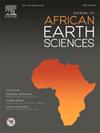基于holissurface方法的剪切波速场地分类与土壤液化评价
IF 2.2
4区 地球科学
Q2 GEOSCIENCES, MULTIDISCIPLINARY
引用次数: 0
摘要
本研究采用holissurface技术,一种地球物理方法,对加纳大阿克拉地区西南部的遗址进行分类并评估液化易感性。从26个调查地点获得了13 m深度的横波速度(v)剖面。然后使用可靠的外推方法估计每个站点的Vs30(Vs30(13)),允许基于欧洲代码8系统进行分类。大多数站点(20个)被分类为C类站点(Vs30: 180-360 m/s),表明中等密度的土壤在深度上具有改善的地质力学特性。五个站点显示出高刚度和抗液化(站点B级)。然而,Tetegu East站点(Vs30: 110 m/s, FoS: 0.525)被发现非常脆弱(站点D级),因此容易发生地震破坏。空港城(Vs30: 190 m/s, FoS: 0.647),尽管为站点C级,但FoS值较低,表明液化易感性。本研究的一个关键限制是,由于大多数站点的空间限制,无法获得30 m深度的Vs数据,因此需要使用外推的Vs30值,这可能会引入不确定性。此外,由于本研究的初步性质,没有采用与HVSR或RMP曲线联合反演群速度频散的方法来提高可靠性。尽管存在这些局限性,但研究结果与既定标准一致,并为城市规划提供了重要见解,强调了在高风险地区采取干预措施以减轻潜在灾害的必要性。本文章由计算机程序翻译,如有差异,请以英文原文为准。
Site classification and soil liquefaction evaluation based on shear wave velocity via HoliSurface approach
This study employs the HoliSurface technique, a geophysical method, to classify sites and evaluate liquefaction susceptibility in the southwestern Greater Accra Region of Ghana. Shear wave velocity (Vs) profiles to a depth of 13 m were acquired from 26 surveyed sites. A reliable extrapolation method was then used to estimate the Vs30 (Vs30(13)) of each site, allowing classification based on the Eurocode 8 system. Most sites (20) were classified as Site Class C (Vs30: 180–360 m/s), indicating moderately dense soils with improved geomechanical properties at depth. Five sites exhibited high stiffness and resistance to liquefaction (Site Class B). The site at Tetegu East (Vs30: 110 m/s, FoS: 0.525) was, however, found to be extremely weak (Site Class D), hence prone to seismic failure. Airport City (Vs30: 190 m/s, FoS: 0.647), despite a Site Class C classification, exhibited a low FoS value, indicating liquefaction susceptibility. A key limitation of this study was the inability to acquire Vs data to a depth of 30 m due to spatial constraints at most sites, necessitating the use of extrapolated Vs30 values, which may introduce uncertainties. Additionally, joint inversion of group velocity dispersion with HVSR or RMP curves, which could enhance reliability, was not employed due to the preliminary nature of this study. Despite these limitations, the findings align with established standards and provide critical insights for urban planning, highlighting the need for interventions in high-risk zones to mitigate potential disasters.
求助全文
通过发布文献求助,成功后即可免费获取论文全文。
去求助
来源期刊

Journal of African Earth Sciences
地学-地球科学综合
CiteScore
4.70
自引率
4.30%
发文量
240
审稿时长
12 months
期刊介绍:
The Journal of African Earth Sciences sees itself as the prime geological journal for all aspects of the Earth Sciences about the African plate. Papers dealing with peripheral areas are welcome if they demonstrate a tight link with Africa.
The Journal publishes high quality, peer-reviewed scientific papers. It is devoted primarily to research papers but short communications relating to new developments of broad interest, reviews and book reviews will also be considered. Papers must have international appeal and should present work of more regional than local significance and dealing with well identified and justified scientific questions. Specialised technical papers, analytical or exploration reports must be avoided. Papers on applied geology should preferably be linked to such core disciplines and must be addressed to a more general geoscientific audience.
 求助内容:
求助内容: 应助结果提醒方式:
应助结果提醒方式:


